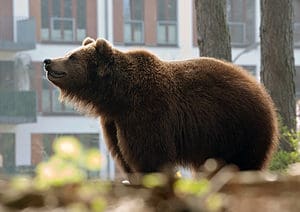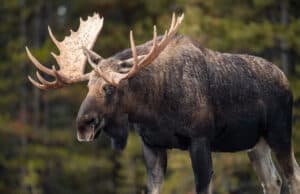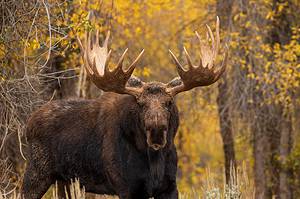A moose is an animal found in the forests of Canada and throughout the northern hemisphere. There are many people who have never had the chance to see a moose in person or are unfamiliar with the animal, so they might imagine something similar to a deer. However, in reality, the moose is a very unique and distinct species with a specific set of qualities and characteristics which makes it one of a kind! For example, moose are huge, with an average weight of 1,500 pounds for males.
Since they are such a unique species, it is only natural that their mating season would be unique as well. This article will help you learn more about moose mating season, whether you want to stay safe or simply find out more about them! So when do moose breed? Let’s find out!
When Is Moose Mating Season?
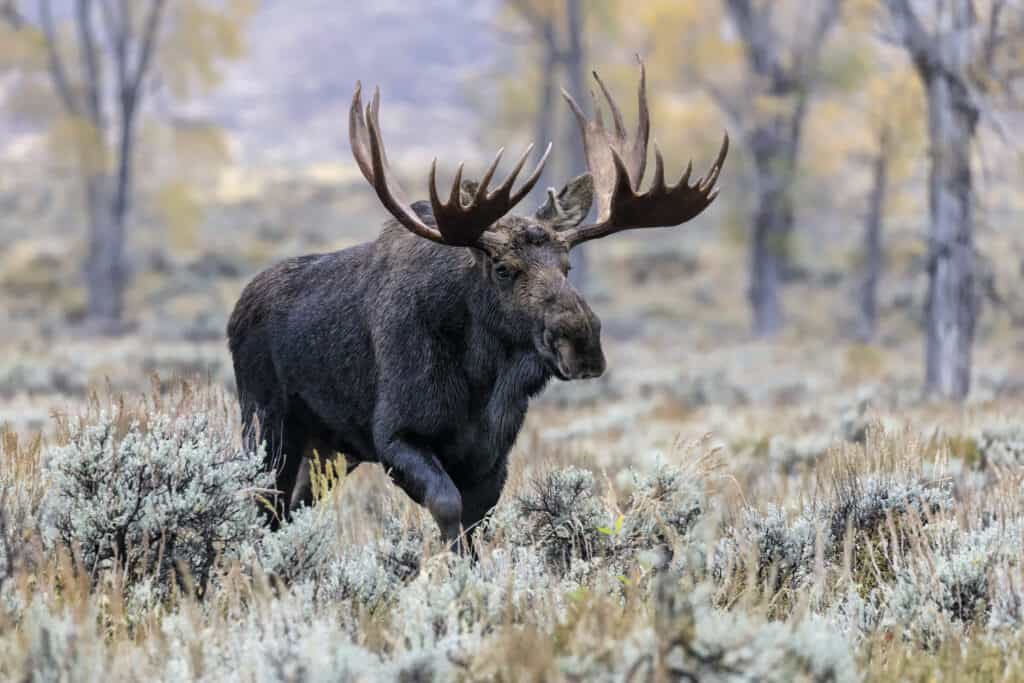
Moose mating season begins in September and ends in October.
©David Osborn/Shutterstock.com
The majority of the year, moose lead an unremarkable existence. In general, they spend much of their time eating, sleeping, and traveling from place to place. However, all of that quickly changes during moose mating season, also known as rut season. Moose mating season takes place between the months of September and October. Unlike caribou and Dall’s sheep, moose do not live in groups. During winter, spring, and summer, moose typically avoid other moose.
A year’s worth of socialization and rutting takes place as autumn approaches causing moose’s lives to change dramatically. In the course of moose reproduction rituals, behaviors that were dormant for a year start to emerge. There is brewing chaos between bulls and cows as they scuffle over breeding rights, and cows take advantage of the bulls’ attempts to mate and use the bulls for breeding purposes.
So what are some of the behavioral changes that happen? Let’s learn all about them.
Moose Mating: Season Behavioral Changes
A moose’s mating season starts every fall. It is usually between the end of August and the beginning of September that rutting behaviors begin.
Let’s take a look at these behaviors in more detail:
Bulls Will Move to Lower Elevations
It is normal for bull moose to move in search of cows as soon as the season begins. The majority of bull moose are found in dense, cool forest areas at higher elevations, where they usually stay for most of the year. It is, however, common for cows to stick around lowland areas near water as opposed to the highlands. As well as offering food, the water offers cows a way to escape from predators, so their calves spend a lot of time here when they are vulnerable to predators. When the mating season begins, bulls are more likely to move down to lower elevations so that they can locate cows to breed with.
Scent Marking
A bull moose marks its territory with its scent. Scent marking is a way for bulls to claim their territory, establish dominance over other bulls, and attract cows that are in heat. During mating season, bulls beat their antlers against shrubbery to signal their dominance to cows and other bulls. When they roam during the rut, they also make rut pits and wallows. It is believed that bulls do this to make themselves more appealing to cows by digging shallow urinal pits, urinating in them, and then lying down in them.
Fighting With Other Bulls
A bull’s strength can be assessed through sparring. When bull moose are in rutting season, they are more aggressive, fighting constantly and sparring frequently. It is common for two bull moose to fight in a competition for cows during which they try to intimidate and scare each other off. There is a great deal of tension in fights, and they are often quick, and they result in more injuries than sparring. As opposed to fighting, sparring is a different kind of activity because it is more about a bull testing his abilities and proving his dominance rather than if it would like to capture a cow.
Mating
In the end, mating begins. The mating season begins around the third week of September. As soon as a cow goes into heat, it calls for a bull to come near her. It is common for cows to vocalize regularly in order to communicate with one another. There will be a noticeable increase in the volume and duration of these calls when mating season comes around. The sound has a nasally quality to it, and it usually has a high pitch beginning and ending. When a cow is in heat, her call lasts anywhere from five seconds to as long as 30 seconds. The first week in October marks the end of the rut for moose, who transition into the winter by eating, resting, and storing fat. Calves are carried by cows until May when they are born. There will be no rutting behavior until the following autumn.
How to Avoid Getting Hurt During Rutting Season
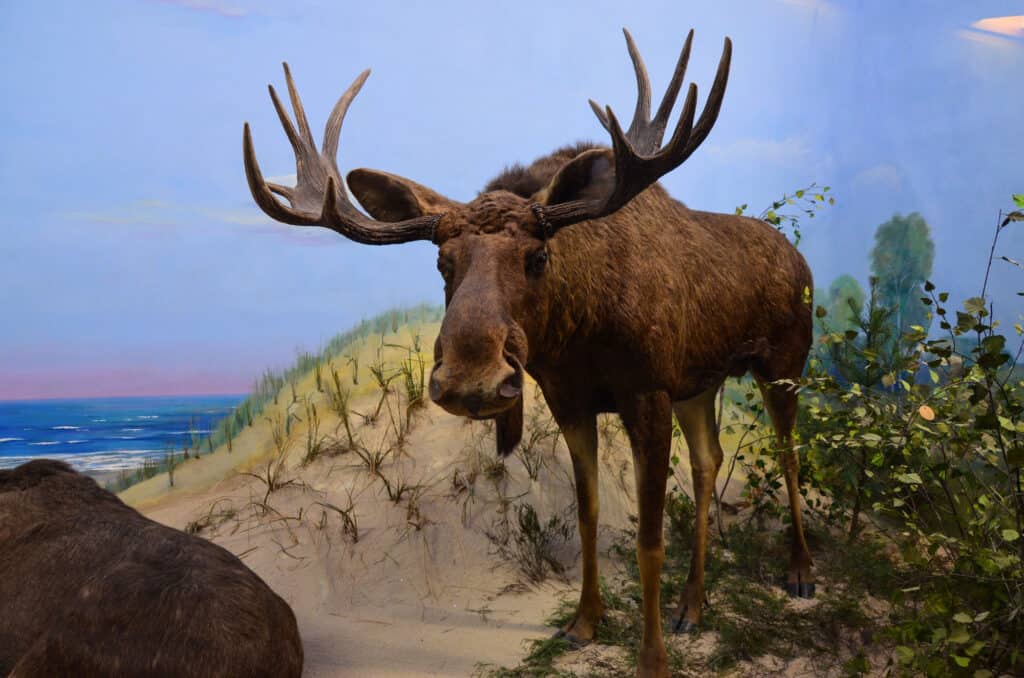
Although they are large and slow-moving, moose can actually attack you if they feel threatened.
©D.serra1/Shutterstock.com
People often assume that moose, which are slow-moving giants, will be friendly toward them. This is not the case. Moose can become aggressive if they feel threatened. In fact, during mating season, these animals are even more on edge and more likely to hurt you. However, there are ways to keep yourself safe and avoid being attacked by a moose.
Moose during rut season should not be approached in the following ways:
- It is not a good idea to get too close to the moose or feed, pet, or even take selfies with it. Keep at least 25 feet away from the wildlife, preferably more.
- Keep your dog by your side when you are around a moose. Due to their close resemblance to wolves, the moose’s only predator, leashed or unleashed dogs may run the danger of being stomped on by a nervous moose.
- Avoid walking in front of the moose. Make sure to get to your destination another way if you are in the path of a moose. Turn your palms outward as you slowly back off. Demonstrate that you do not intend any harm by speaking softly.
- It is not safe to drive past moose. It is important to yield to moose when driving if you encounter one in rut. Trying to move your car when it is inactive on the road or resting may cause it to assault you.
Signs That a Moose Is Ready to Attack
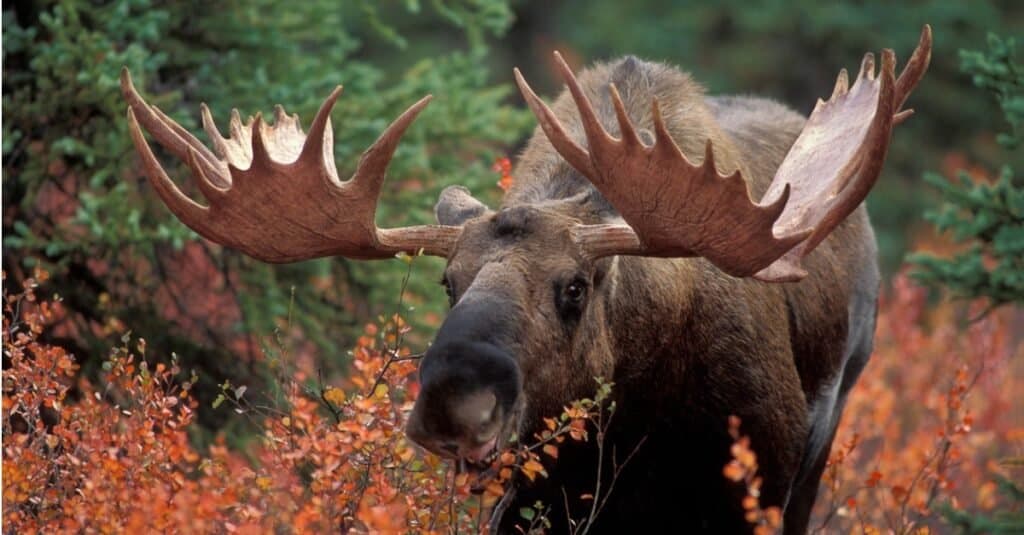
Pay attention to any clear warnings signs, such as grunting or foot stomping, as they mean a moose may attack.
©iStock.com/RONSAN4D
In order to warn you before attacking, moose give out clear warning signs. You’ll recognize a moose is ready for battle by its signs, such as:
- The stomping of feet and grunting
- Ears with flattened tips and flinging heads
- The lips are curled back and the teeth are visible
- They begin to approach you
As soon as this happens, you have to prepare yourself to face an attack. It is common for moose to feign an attack, but they have a very good chance of following through. Try to place a large object between yourself and the moose, such as a tree if you need to. During the charge of a moose, if you feel your vital organs, your head, and your neck are at risk, drop and curl up into a ball to protect yourself.
It’s a good thing, however, that moose are more lazy than they are active. A moose’s main passion is eating. Additionally, moose are herbivores, which means they’re not predators, but rather prey. There is a good chance that a moose will not chase you if you run from it as it won’t see the point in continuing to chase you. However, it is still always important to remain vigilant and to avoid disturbing a moose whenever you are out in the wild.
Up Next:
- Dog Mating Season: When Do They Breed?
- Spider Mating Season: When Do They Breed?
- When is Skunk Mating Season: When Do They Breed?
The photo featured at the top of this post is © RT Images/Shutterstock.com
Thank you for reading! Have some feedback for us? Contact the AZ Animals editorial team.




